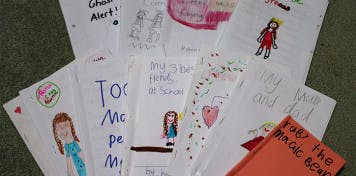


How to Improve Writing Skills for Children in 11 Easy Steps

The best way to teach children how to write is with clear and explicit instruction. Plus, make it fun and engaging of course!
According to an extensive study by the Australian Education Research Organisation (AERO) there has been a decline in children’s writing skills over the last seven years. From 2011 to 2021 AERO analysed 10 million NAPLAN writing results. The key findings demonstrate a dramatic drop in children’s writing abilities and serious long-term implications.
The unnerving results indicate that more attention needs to be focused on teaching children how to write to solidify this crucial skill. According to this research, the explicit teaching of writing needs to be [prioritised] across all subjects throughout kids’ school careers. The report stated some alarming writing statistics, with a pronounced dip in the following areas:
Persuasive Writing – Only 15% of Year 9 students used persuasive devices effectively.
Sentence Construction – 85% of Year 9 students are constructing sentences at or below Year 7 level.
Punctuation – Most Year 9 students applied punctuation to their writing at a Year 3 level.
The good news is there are easy, fun writing activities and ideas that parents or carers can use to teach kids how to write. It’s important to instil a love of writing in children and make sure they understand that writing has a purpose. Children need to understand why they are writing, who they are writing for and that we write for all kinds of reasons.
How to Improve Your Child’s Writing Skills (11 Easy Tips)
Want some practical ways to help teach your child how to write? Try these 11 simple writing tips to help strengthen their writing skills and don’t forget to praise their efforts along the way.
1. Set up your child with a place to write and writing supplies
It’s a great idea to provide a comfortable place where children can write. Kids love to experiment so provide them with a variety of writing materials and implements. Supply colourful crayons, markers and beginner pencils that are easy to hold for emerging writers.
Excite older children with different kinds of papers, diaries, pencils, pacers, markers and pens. Just like a book nook, this needs to be a space that inspires children and that they enjoy using.

Engaging in fun, creative writing activities and using well-designed online writing games is the perfect way to keep children motivated. Free Trial
2. Explain to kids that writing has a purpose
It’s important that children understand that there are many purposes to writing. Some of the reasons we write are to inform, persuade, entertain or explain. Writing is also a great way to express feelings.
3. Model writing to children
Seeing adults write is a great way to show children where writing fits into daily life and it offers a chance to explain why we write and in what context. Help your child see how necessary writing is and how enjoyable it can be to write.
Show them how often you write during your day for all kinds of reasons; Children can then get involved in practical writing activities at home, such as contributing to the family calendar, diary, noticeboard, or messages on the fridge.
Use opportunities where your child can contribute, such as letting them write their name on a birthday or thank you card, rather than writing it for them.
Help your preschooler or get your older child to write letters to their grandparents, a friend, or even their future selves. If your child loves gags encourage them to write jokes to share with their family.
Plan a fun, purposeful writing activity where they won’t even realise they’re practising their writing skills! For example, get your child to trace or write the labels for pantry items or caption photos in a scrapbook.
4. Writing practice for preschoolers and kindergarten kids
If your child is new to writing, start with beginner skills like pencil grip practice and tracing the letters of the alphabet. Show your child how to hold a pencil with three fingers, in a tripod grip. This will give them more control when they write. Show your child how they can trace their ABCs with their finger in alphabet books or printouts.
They can also hone this skill on the go with an online reading program, such as Reading Eggs. There are plenty of colourful activities where kids can practise tracing letters with helpful guidance from the program.

Reading Eggs Junior offers fun, guided letter tracing activities that teach children how to write the alphabet. Try it for free today!
Once your little one has mastered tracing, move on to freehand writing of letters. Shaving cream on a shower screen is a fun, tactile way for kids to practise this skill. Try a few letters each night at bath time.
Also, give them lots of encouragement with writing the alphabet on paper and eventually congratulate your child on the big milestone of writing their name. It’s also okay for kids to copy writing at a young age too.
5. Daily reading practice helps with kids' writing
Reading helps with writing, and vice versa. Read together every day when your child is younger to strengthen their writing skills. Just by cuddling up with a book, they’ll be working on everything from their vocabulary, spelling to comprehension. Allow children to lead with their interest in books, by choosing from hundreds of e-books on all topics in the Reading Eggs Library.
Discuss what you’re reading with your child and ask them about the books they read, too. Ask more complex questions depending on your child’s age. Make sure they’re understanding the text.
Get your child to read their writing to you, or you can read it out loud to them. Don’t forget to praise them for their efforts! Point out when they’ve used great adjectives, spelled a difficult word correctly or tried to write neatly.
Try Reading Eggs for FREE today!
Reading Eggs is the multi-award winning online reading program that makes learning to read and write fun for kids aged 2 to 13. Build their reading and writing skills with hundreds of online lessons, printable worksheets, the Story Factory and over 3500 e‑books to delight and inspire. Start your 30-day free trial today.
6. Use writing printables and worksheets to build kids’ writing skills
Make it easy for yourself by taking advantage of engaging resources such as free writing printables. Preschool and kindergarten children need lots of practice so print out different variations for beginning skills.
Build on this by seeking out more challenging printables for older children to help introduce concepts like verbs, nouns or adjectives and how they can use them in their writing.
7. Make writing fun to motivate children
Help children develop their writing skills by playing fun writing games. This is the best way to keep kids on track, so they complete the activity they are practising without even realising they’re learning.
Get back to basics with this sentence-level work activity for younger children:
Write simple sentences together then cut out the verb from each. Cut up a pile of other verbs so that the child can generate different sentences.
For example, I run in the park. skip…hop…play…ride…dig etc. They can then write out one or all of the sentences.
Children who are more advanced with their writing skills can create a script for a play and then get dressed up and perform it. They’ll love seeing their writing come to life! Conduct an interview, providing them with written questions they can answer as a famous playwright. Ask what inspired their script and what they were trying to say.
Online writing activities within safe kids' games are another way to keep your child engaged with writing and they can do this on the go which is a bonus!
8. Take the pressure off with creative writing prompts for kids
Creative writing prompts are a fantastic way to get children writing, while avoiding the dreaded refrain they love to use, “I don’t know!” Use pets, favourite characters and questions that make them think in order to help them write.
For younger kids’ writing prompts, try simple sentences where they can suggest a word. If they’re not able to spell or write yet, write it for them and praise them for their contribution. They can copy the word or the whole sentence if appropriate. Help your child form the letters and spell the words. If they’re learning to write words simple words, they can add the word themselves.
Writing prompt ideas for preschoolers or kindergarten children:
My favourite animal is a ….
I like to eat …
… makes me happy
My favourite colour is …
I am … years old
Ask older children to expand on their answers. It could be a sentence, a paragraph, or even longer if they’re keen to write more. Give these writing prompts a go for primary school-aged children, and adjust according to their age or ability:
What is your favourite movie character and why?
What would you choose as your superpower and how would you use it in your everyday life?
Who is your best friend? What do you enjoy doing when you’re together?
9. Kids’ writing activities for preschoolers to teens
Make learning to write fun to encourage and motivate the child. For preschoolers try pre-writing activities such as:
Flour tray finger writing
Create Play-Doh letters together
Pretend writing with a crayon on paper and get them to tell you what they’ve written.
Repetition with online games is a great way to get concepts to stick for children young and old, without the mess!
For older children, why not try a persuasive writing activity? According to the AERO study, this was a skill that children struggled with. Explain the purpose of persuasive writing to your child. Persuasive texts give a point of view that is factual. They are used in writing to influence or persuade others.
If your child is keen on the latest fad toy, desperate for a pet or after the birthday party of their dreams, get them to write about it. Ask them to convince you with their very best persuasive writing.
10. Helping children write their own story or even a book!
From the time they are tiny, children love being read to or told a story. Many of us incorporate bedtime stories into their routines. Once they’ve started on their writing journey, why not help your child to write a story?
For younger children, parents can act as scribes, so kids can see that their spoken words and ideas can be mapped to letters and constructed as sentences. Your child can eventually have a go at writing random letter strings and you should encourage them to tell you what they are writing.
This will reinforce the idea that writing has purpose and value. You can then display your child’s writing or work with them to turn it into a book!
Discuss that stories can come in all kinds of formats. If your child loves comic books, poems, or graphic novels, show them how they can create their own.
Allow your older child to let their imagination run wild too, coming up with their own short story or chapter book if they’re ready to create one. Don’t forget to praise what they’ve come up with and how they’ve written it.
Your child can write their own story with Story Factory
Reading Eggs’ Story Factory feature gives children a step‑by‑step guide to writing a story – perfect for encouraging your child's writing skills at home. Weekly contests give children the chance to collect 200 Golden Eggs. If your child wins the contest, their written book is added to the library for everyone to read.
11. Introduce your child to the joy of keeping a journal
Show your child that their point of view matters and how powerful the written word can be with a journal. Self-expression is an important part of learning to write and is also a great way to get emotions out for children and help their mental health.
A writing journal is a brilliant way to get into a daily writing routine without worrying too much about writing perfectly.
You can also encourage your child to keep track of the books they've read with a reading journal. Ask them to write a simple sentence or two on what they liked about the book, who their favourite character was and how they would rate the book overall. This will not only help with keeping track of all the books they’ve read but also develop their writing and comprehension skills.
Check out the reading journal in Reading Eggs that will foster a love of reading and writing in your child:
Try the Reading Eggs Journal for Free
Your child will love writing about all the books they are reading today in the most fun, motivating way! Get them started with a free trial of Reading Eggs and they’ll also have access to hundreds of engaging reading games and activities to hone crucial literacy skills.
How to use Reading Eggs to encourage children to write
Reading Eggs is dedicated to helping children master all the crucial literacy skills that keep them on track for success as young learners, at school and beyond. Developed by educational experts, there are hundreds of literacy games and activities to hone skills from the time they are two until they hit their teens.
The program grows with your child and works at their very own level. Plus, there are motivating prompts like the Story Factory and the Reading Journal to encourage them to flex their writing muscles every day.

The Story Factory – This interactive feature within Reading Eggs gives kids the opportunity to create their very own story books, with full-colour illustrations! Once they’ve written their masterpiece, you can print it out to create a real book your child can hold in their hands. A digital version of your child’s story books can also be saved in the bookshelf of their house within the program.

The Reading Journal – Inspire a love of reading and writing in your child! This exciting interactive and customisable feature gives kids an opportunity to practise their writing skills. It also gives them ownership over the books they choose to read and tracks what they thought of their reading experience. Your child will have fun decorating each page with colourful digital 'stickers'.
The Long-Term Benefits of Teaching Children How to Write Effectively
Poor writing ability can affect children in their future schooling or career and can be detrimental to their confidence. Start helping your child with the easy tips above. Educational programs that take children through all the important steps needed to solidify their literacy skills are also a way to safeguard them from falling behind and feeling overwhelmed.
AERO has recommended that the importance of teaching writing be elevated across schools. As parents, we can also give our children a leg up so they can become strong writers during their school years and beyond.
Children’s poor writing skills can be detrimental in multiple ways, so it’s best to address and keep focused on harnessing this skill set from the time they are beginning writers. Avoid problems snowballing as they make their way through their school years. It can affect social situations and their future workplace. It’s never too early or late to start honing children’s writing skills.
Support your child to learn how to write so they don’t fall behind. Who knows, your child could be the first writer in your family to crack the bestseller books lists thanks to your efforts and Reading Eggs!
Try Reading Eggs for FREE today!
Reading Eggs is the multi-award winning online reading program that makes learning to read and write fun for kids aged 2 to 13. Build their reading and writing skills with hundreds of online lessons, printable worksheets, the Story Factory and over 3500 e‑books to delight and inspire. Start your 30-day free trial today.






